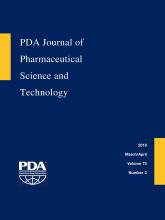Abstract
Cross contamination is a major concern in the pharmaceutical industry, especially with long - term dosing and possible cumulative effects. The risk depends on many factors that can be divided into three main groups: individual related—starting from the individual's genomic makeup, age, sex, environment, and even diet and psychological state, which in turn alter the individual's response to contamination and to any active pharmaceutical ingredient (API); formulation related—the API's cleanability, solubility, batch size, maximum daily dose, and most importantly permitted daily exposure (PDE), which covers the toxicological profile of this API, including its genotoxicity, reproductive toxicity, sensitizing potential, or any adverse effects that would result from long- or short - term cross contamination; and facility related—as the machine shared surface area between Product A as the contaminant and Product B as the contaminated. The following approach is based on EMA recommendations on health - based exposure limits. It aims to address all three of the aforementioned groups to give a scientific rationale on how to evaluate the cleaning process efficiency.
LAY ABSTRACT: This manuscript aims to provide a health-based exposure limit for acceptable carryover of one pharmaceutical product to another in a multiproduct pharmaceutical facility, owing to the manufacturing of more than one product on the same machine line, without any affects upon or side effects in patients. The risk assessment of cross contamination is affected by many factors, related to either the patients taking the pharmaceutical products or the pharmaceutical product itself.
Factors related to patients include those that might alter the individual's responses toward active pharmaceutical products; for instance, the cytochrome P450 (CYP) liver enzyme family is responsible for the breakdown of more than 30 different classes of drugs. Patients having less active or inactive forms of CYP enzymes cannot metabolize or eliminate certain drugs, leading to accumulation and increased toxicity of those drugs. Aging also affects the metabolizing process of drugs. Other factors can affect an individual's response toward any drug, and these effects range from minor to major.
The factors related to the facility or formulation itself also have a major impact on the determination of maximum allowed carryover between two products; for instance, a potentially carcinogenic active pharmaceutical ingredient must have a lower accepted carryover than a noncarcinogenic one. Smaller batch size poses a larger threat when the batch is contaminated with the same amount of contaminant as a larger batch, and a large surface area machine train poses a larger risk for contamination.
- Cleaning validation
- Cross - contamination risk assessment
- Health - based exposure limits
- Chemical swab limits
- Chemical contamination
Abbreviations:
- API
- Active pharmaceutical ingredient
- EMA
- European Medicine Agency
- GIT
- Gastrointestinal tract
- ICH
- International Committee of Harmonization
- MACO
- Maximum allowed carryover
- PDE
- Permitted daily exposure
- SAL
- Surface area limit
- SSA
- Shared surface area
- © PDA, Inc. 2019
PDA members receive access to all articles published in the current year and previous volume year. Institutional subscribers received access to all content. Log in below to receive access to this article if you are either of these.
If you are neither or you are a PDA member trying to access an article outside of your membership license, then you must purchase access to this article (below). If you do not have a username or password for JPST, you will be required to create an account prior to purchasing.
Full issue PDFs are for PDA members only.
Note to pda.org users
The PDA and PDA bookstore websites (www.pda.org and www.pda.org/bookstore) are separate websites from the PDA JPST website. When you first join PDA, your initial UserID and Password are sent to HighWirePress to create your PDA JPST account. Subsequent UserrID and Password changes required at the PDA websites will not pass on to PDA JPST and vice versa. If you forget your PDA JPST UserID and/or Password, you can request help to retrieve UserID and reset Password below.






